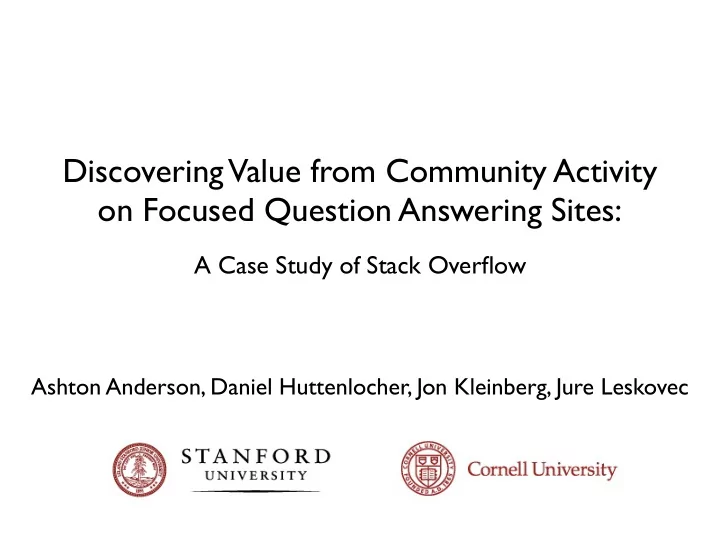

Discovering Value from Community Activity on Focused Question Answering Sites: A Case Study of Stack Overflow Ashton Anderson, Daniel Huttenlocher, Jon Kleinberg, Jure Leskovec
Intro + Motivation Q&A sites have evolved: from places to get one-off answers to questions to large repositories of long-lasting, valuable knowledge
Intro + Motivation In this work, we promote a systemic view of Q&A sites Rather than focus on question-answer pairs, we view a question together with its full set of answers We show that this new approach can help solve important problems in modern Q&A sites Early identification of pages with long-lasting value Finding questions with insufficient answers
Outline 1. Data 2. Introduce tasks 3. Empirical findings 4. Task performance
Outline 1. Data 2. Introduce tasks 3. Empirical findings 4. Task performance
Data Large, focused programming-related Q&A site Very well curated by the community Users 440K Questions 1M Answers 2.8M (26% marked as accepted) Votes 7.6M (93% positive) Favorites 775K (on 318K questions) Complete dataset
Reputation Stack Overflow is endowed with a highly respected reputation system Action Reputation Change Q/A is upvoted +5/+10 Q/A is downvoted -2 (-1 to voter) Answer is accepted +15 (+2 to acceptor) Answer wins bounty + bounty amount - bounty amount Offer bounty Answer marked as spam -100
Outline 1. Data 2. Introduce tasks 3. Empirical findings 4. Task performance
Tasks Two questions from the Q&A site owner’s perspective: 1. Predict long-term value of a question page help guide consumers of information to high-quality content 2. Predict whether a question has been sufficiently answered help direct producers of information to questions in need of expert attention What features should we use to predict this?
Outline 1. Data 2. Introduce tasks 3. Empirical findings 4. Task performance
Is there a relationship between the site-level reputation system and question-level dynamics? } # answers Higher-rep users arrive earlier
First principle: Reputation Pyramid Time 10 5 10 4 10 3 10 2 10 1 10 0 Rep Mental model, not an explicit structure
The longer it takes for the first answer to arrive, the less likely that any answer will be accepted Consistent with reputation pyramid picture!
Two competing notions of answer quality: Better vote Earlier Later More rep points score Resolving these 2 notions is an open problem
Second Principle: “rising tide lifts all boats” Is there competition between answers? (log base 10) more votes for everybody More activity Supports our systemic view of Q pages
Outline 1. Data 2. Introduce tasks 3. Empirical findings 4. Task performance
Task 1 : predict long-term value of a question page given how it looks a short time after it is created Long-term value = Number of page-views one year after creation (in our data) See one hour of data, predict views one year later Set up as binary classification task: high/low page-views We optimize for simplicity and interpretability use logistic regression
Features Set Description (# feats) Examples reputation, number of previous A Questioner features (4) Qs, ... highest answer score, highest B Activity & Q/A quality (8) answerer rep, ... average answerer reputation, # comments on answer by highest C Community processes (8) reputation answerer, ... average time between answers, D Temporal processes (7) time for highest-scoring answer to arrive, ...
Compare against “crowd-sourced” baseline: # favorites on question and question score (upvotes-downvotes) – 2 explicit mechanisms that measure value We perform feature selection and end up using 8 important features (S 8 ):
Results Top 25% vs. Bottom 25% Top 50% vs. Bottom 50% Features of the community processes that underlie the creation of the entire question page are useful for discovering long-term value at a very early stage
Task 2 : Predict whether a question has been sufficiently answered Setup: Given features of a question page, determine whether the question is about to accept one of the existing answers or offer a bounty – Same logistic regression framework (with a balanced dataset) – No natural baseline, so we compare our 4 classes of features – Again perform feature selection, narrow down to set of 18 features
Results – Task 2 – Questioner features are powerful – But adding features of community + temporal processes significantly boost performance Features of the community processes underlying Q&A activity can provide important early indications
Conclusion Q&A sites have evolved into focused communities We suggest a shift in perspective from question- answer pairs to viewing questions together with their complete set of answers as one unit There is useful information in the community and temporal processes for tasks like predicting long-term value and deciding if a question needs help
Thanks!
Recommend
More recommend